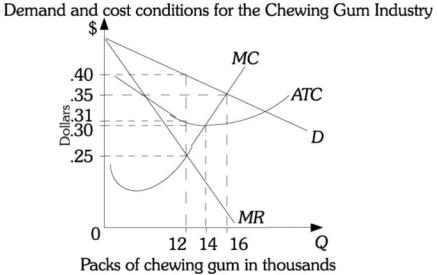A) A concentrated industry
B) An oligopoly
C) A cartel
D) Price leadership
Correct Answer

verified
Correct Answer
verified
True/False
The government uses the four firm concentration ratio as a guideline to determine which proposed mergers are acceptable.
Correct Answer

verified
Correct Answer
verified
True/False
Game theory was first developed by John Nash.
Correct Answer

verified
Correct Answer
verified
True/False
Game theory enables economists to fully understand and predict the behavior of oligopolistic industries with more than two firms.
Correct Answer

verified
Correct Answer
verified
True/False
Oligopolists compete on price but not quality.
Correct Answer

verified
Correct Answer
verified
True/False
An industry in which there are five firms each accounting for 20 percent of the market has an HHI of 100.
Correct Answer

verified
Correct Answer
verified
Multiple Choice
Refer to the information provided in Table 14.3 below to answer the question that follows. Table 14.3 B's Strategy -Refer to Table 14.3. The result of this game is a prisoner's dilemma. In which of the following cases is it most likely that the firms will be able to overcome the prisoner's dilemma?
A) repeated play
B) a single interaction
C) when both firms follow a maximin strategy
D) government intervention
Correct Answer

verified
Correct Answer
verified
Multiple Choice
Refer to the information provided in Table 14.2 below to answer the question that follows. Table 14.2 B's Strategy -Refer to Table 14.2. If both firms follow a maximin strategy, the equilibrium in the game is ________.
A) (Advertise, Advertise)
B) (Don't Advertise, Don't Advertise)
C) (Don't Advertise, Advertise)
D) (Advertise, Don't Advertise)
Correct Answer

verified
Correct Answer
verified
Multiple Choice
In general, oligopolists compete
A) on price alone.
B) on many dimensions except for price.
C) on price, R&D, and marketing and advertising.
D) None of the above. There is no competition in oligopolistic industries.
Correct Answer

verified
Correct Answer
verified
Multiple Choice
Refer to the information provided in Figure 14.7 below to answer the questions that follow.  Figure 14.7
-Refer to Figure 14.7. Six firms that produce chewing gum form a cartel. The cartel faces the market demand curve given by D. To maximize profits, the cartel should produce ________ packs of chewing gum and the price should be ________.
Figure 14.7
-Refer to Figure 14.7. Six firms that produce chewing gum form a cartel. The cartel faces the market demand curve given by D. To maximize profits, the cartel should produce ________ packs of chewing gum and the price should be ________.
A) 12,000; $.25
B) 12,000; $.40
C) 14,000; $.30
D) 16,000; $.35
Correct Answer

verified
Correct Answer
verified
Multiple Choice
In an oligopolistic industry, the price firms charge and the quantity they produce would be the same as if the industry were a monopoly if
A) the market is contestable.
B) the oligopolists behave as Cournot assumed.
C) one of the oligopolists acts as a dominant firm price leader.
D) the oligopolists collude.
Correct Answer

verified
Correct Answer
verified
Multiple Choice
A(n) ________ industry is characterized by strategic behavior.
A) perfectly competitive
B) monopolistic
C) monopolistically competitive
D) oligopolistic
Correct Answer

verified
Correct Answer
verified
True/False
The product differentiation of firms in an industry is an indicator of the size distribution of firms.
Correct Answer

verified
Correct Answer
verified
Multiple Choice
Which of the following are benefits associated with the oligopoly model?
A) allocative efficiency
B) pricing at marginal cost
C) product variety and innovation
D) None of the above are benefits associated with the oligopoly model.
Correct Answer

verified
Correct Answer
verified
Multiple Choice
The conclusion that firms in oligopoly always produce where price exceeds marginal cost is true for all models of oligopoly EXCEPT the
A) collusive oligopoly model.
B) price-leadership model.
C) Cournot model.
D) contestable market model.
Correct Answer

verified
Correct Answer
verified
Multiple Choice
The market structure in which the behavior of any given firm depends on the behavior of the other firms in the industry is
A) perfect competition.
B) monopoly.
C) monopolistic competition.
D) oligopoly.
Correct Answer

verified
Correct Answer
verified
True/False
Refer to the information provided in Table 14.1 below to answer the question that follows. Table 14.1 B's Strategy -Refer to Table 14.1. Firm A does not have a dominant strategy.
Correct Answer

verified
Correct Answer
verified
True/False
Markets in which entry and exit are difficult are known as contestable markets.
Correct Answer

verified
Correct Answer
verified
True/False
When all players play their best strategy given what their competitors are doing, they are following their dominant strategy.
Correct Answer

verified
Correct Answer
verified
Multiple Choice
To the extent that oligopolies differentiate their products,
A) there is overproduction from society's point of view.
B) they force themselves into deadlocks that waste resources.
C) there is the promise of new and exciting products.
D) they are also likely to price at marginal cost.
Correct Answer

verified
Correct Answer
verified
Showing 21 - 40 of 110
Related Exams